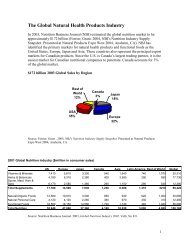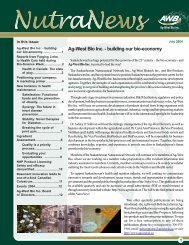Beyond Borders: Global biotechnology report 2010
Beyond Borders: Global biotechnology report 2010
Beyond Borders: Global biotechnology report 2010
Create successful ePaper yourself
Turn your PDF publications into a flip-book with our unique Google optimized e-Paper software.
for biotech’s sustainability — that the<br />
business model the industry has long<br />
thrived on would be starved of its key input<br />
(funding) and companies’ efforts to cull<br />
their pipelines would lower the model’s<br />
key output (innovation). We wondered<br />
whether recovery, when it came, might<br />
bring not a return to normal, but rather the<br />
emergence of a “new normal,” requiring<br />
new models for sustainability. And we<br />
described four paradigm-shifting trends<br />
that could potentially create a path to more<br />
sustainable business models in the future.<br />
A year later, the dust has settled and the<br />
outlines of a new normal are indeed starting<br />
to emerge. In both the general economy<br />
and the biotech industry, the worst is<br />
clearly over, but things are not reverting to<br />
business as usual. And in many ways, the<br />
experience of the global biotech industry so<br />
far has mirrored that of the global economy.<br />
For one, while the downturn is commonly<br />
referred to as the global financial crisis<br />
or global recession, it has, in reality, had<br />
divergent impacts on different parts of<br />
the globe. While most industrialized nations<br />
and many developing countries suffered<br />
through recessions in 2009, some emerging<br />
economies — most notably China and<br />
India — continued to see unabated<br />
economic growth.<br />
While several economies have started<br />
to emerge from recession in late 2009<br />
and early <strong>2010</strong> (based on the official<br />
yardstick of GDP growth) and global stock<br />
markets are approaching pre-crisis levels,<br />
unemployment has remained stubbornly<br />
high, particularly in the US. The worst of the<br />
credit crisis has successfully been abated,<br />
but bank lending standards remain tight.<br />
This, coupled with an uncertain market<br />
environment, has lowered hiring at small<br />
businesses — traditionally a key engine<br />
of job creation. Amid talk of a prolonged<br />
“jobless recovery,” most economists now<br />
expect that high unemployment levels will<br />
remain part of the new normal for some<br />
time to come, with potential implications for<br />
economic and social stability.<br />
The situation for biotech is similarly<br />
mixed. On the surface, it would appear<br />
that the worst is indeed over. Aggregate<br />
funding levels rebounded nicely in 2009<br />
and strategic alliance activity remains<br />
robust. Financial performance has<br />
been fairly strong — particularly under<br />
the circumstances — with remarkable<br />
improvement on the bottom line as<br />
companies have engaged in belt tightening.<br />
The market cap of smaller companies,<br />
which had taken a beating, has rebounded<br />
impressively, making up much of the ground<br />
that was ceded in late 2008 and early<br />
2009. (For more on these trends, refer to<br />
the Industry performance section.)<br />
Haves and have-nots: the distribution of financing has become<br />
increasingly skewed<br />
Quintiles of companies based<br />
on capital raised in 2009<br />
2005<br />
Share of US capital raised in:<br />
2006 2007 2008 2009<br />
Quintile 1 68.7% 74.1% 70.6% 74.1% 78.5%<br />
Quintile 2 16.3% 13.4% 15.6% 14.2% 12.5%<br />
Quintile 3 10.3% 7.4% 8.6% 7.5% 5.9%<br />
Quintile 4 3.7% 4.0% 3.9% 3.3% 2.4%<br />
Quintile 5 1.0% 1.1% 1.3% 0.9% 0.6%<br />
Source: Ernst & Young<br />
Haves and have-nots: more of the<br />
same?<br />
While the overall numbers mentioned<br />
above — capital raised, alliance activity,<br />
profitability — are heartening, they only tell<br />
part of the story. Economic dislocations<br />
produce winners and losers, and the real<br />
impact is found not in aggregates and<br />
averages but in measures of variance<br />
and standard deviation. While aggregate<br />
financing levels have held up well, the<br />
availability of capital is challenging for<br />
many companies.<br />
Indeed, our analysis shows that the<br />
distribution of funding has become more<br />
skewed during the last year. In the US,<br />
for instance, the top 20% of fund-raising<br />
companies garnered 74.1% of capital raised<br />
in 2008. In 2009, the proportion raised<br />
by the same quintile of companies had<br />
increased, to 78.5%. Conversely, the 20% of<br />
companies that raised the least funding got<br />
only 0.9% of capital in 2008 and saw their<br />
share shrink even further to a paltry 0.6%<br />
in 2009.<br />
3








